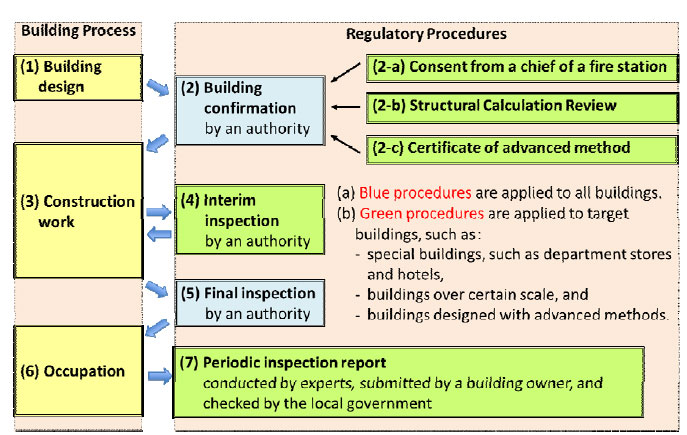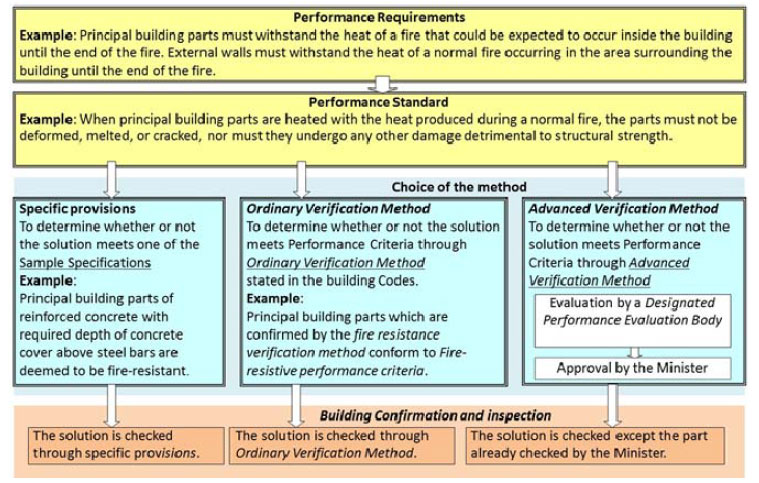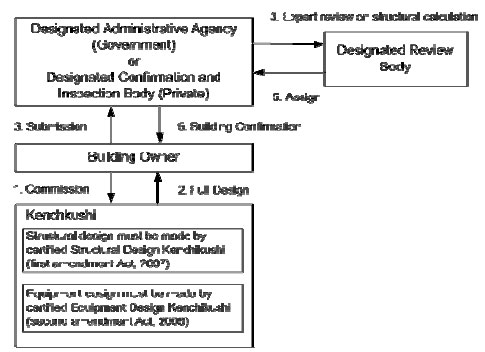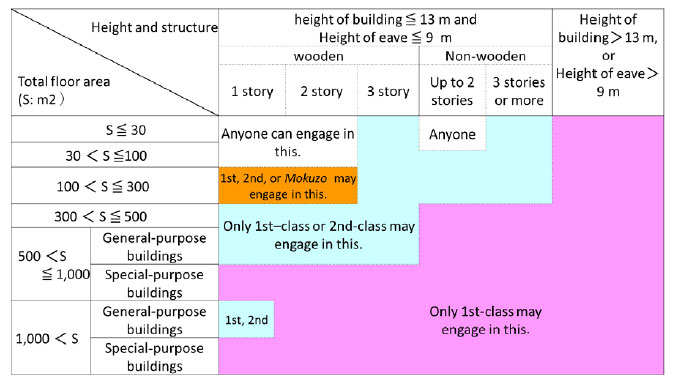Centralized hub for verification of complex fire engineered solutions in Scotland: feasibility study
Independent opinion on the need, appropriateness, potential structure and potential operations of a central hub for assisting in the verification of complex fire engineered designs.
This document is part of a collection
11 Annex A: Three-Routes for Fire Safety Design Compliance in Japan
11.1 Overview
11.1.1 The building regulatory system in Japan is complex, particularly for fire safety, since building fire safety designs must comply with two laws: the Building Standard Law (BSL), which addresses fire resistance, smoke control and egress, and the Fire Service Law (FSL), which address suppression, detection, notification systems, and fire service access.
11.1.2 Both the BSL and the FSL are performance-based. However, there are different routes to compliance. In addition, there are three routes for compliance, depending on whether strict compliance with specific provisions (Route A), compliance with ordinary verification methods (prescribed performance, Route B), or designed using advanced verification (calculation) methods (engineered / performance-based design, Route C). Furthermore, there both governmental and private sector building confirmation and inspection bodies (verifiers), which can be used for Route A or B; however, for Route C designs, the design must be submitted for approval by a minister-appointed designated performance evaluation body. The basic building verification process is illustrated in Figure 11.1 below.
Figure 11.1: Basic Building Verification Process in Japan

11.1.3 Building confirmation (verification) and on-site inspection can be undertaken by one of two types of authorities, as in the figure above: qualified Building Officials working for local government (Designated Administrative Body), or private sector Designated Confirmation and Inspection Bodies. In the case of the latter, the work is undertaken by Conformity Inspectors who have passed a qualifying examination of Qualified Building Regulation Conformity Inspectors. A certificate of compliance issued by a Designated Confirmation and Inspection Body is the same as that issued by a qualified Building Official under the local government. In recent years, most building confirmations are undertaken by Designated Confirmation and Inspection Bodies.
11.1.4 With respect verification of performance-based fire designs (and fire engineered designs, as would be the terminology used in Scotland), the process is illustrated in Figure 11.2 below. As noted above, compliance with the specific (prescriptive) provisions and with the ordinary verification methods (as might be considered C/VM2 in New Zealand) can be approved by a Building Official working for government or by a Designated Confirmation and Inspection Body. However, for an advanced verification method approach (fire engineered design in Scotland, i.e., BS7974 type), evaluation is required by a Designated Performance Evaluation Body.
Figure 11.2: Review Process for Performance-Based Designs in Japan

11.1.5 Details of the Ordinary Verification Methods are stipulated in the Enforcement Order and in the MLIT Notifications. On the other hand, details of the Advanced Verification Methods are not issued by the Government. Designated Performance Evaluation Bodies evaluate the design/solution of a building, using a manual approved by the Minister, then the applicant sends the evaluation body decision, along with drawings, to the Minister to request approval.
11.1.6 As of 2017, there are 27 Designated Performance Evaluation Bodies. For review of fire engineered designs, these bodies engage the most senior researchers and academics in fire in Japan. These specialists tend to be quite conservative, and the benchmark is typically the methods of the ordinary verification methods (i.e., algebraic equations, two-zone fire effects models, etc.). In fact, it has been reported that it is very difficult to get a design approved which uses CFD analysis, given the difficulty in demonstrating verification and validation of CFD codes.
11.1.7 In part, some of this conservatism is a function of the Aneha Scandal in the early 2000s.[2] This was an unfortunate situation in which a Kenchikushi (architect-engineer) engaged in fraudulent structural design calculations, which ultimately were not caught until several hundred buildings had been constructed and occupied. Several of these buildings subsequently had to be demolished because they were so unsafe.
11.1.8 As a result of the Aneha Scandal, the government instituted new requirements for review of structural designs, including the review of software used for structural calculations. A representation of the review process is shown in Figure 11.3 below. As a result of the new review procedures, very few advanced structural designs have been undertaken, since very few computational programs have been verified. In principle, there is one software package which has been verified against the Ordinary Verification Method calculations. In many respects, this situation is mirrored on the fire engineering area.
Figure 11.3: Overview of Review System for Structural Design

11.1.9 A key aspect to the building design system in Japan is the qualification and licensing of Kenchikushi under the Kenchikushi Law. Kenchikushi are essentially architect-engineers, who are licensed to design buildings and to conduct construction administration. The qualifications of Kenchikushi are classified into three types: 1st Class Kenchikushi, 2nd Class Kenchikushi, and Mokuzo (wooden structures) Kenchikushi. In principle, a person who has the necessary educational background and job experience of architecture (university degree) and has passed the official examination can be registered. The Kenchikushi Law stipulates the use, structure, height, etc. of buildings for which only Kenchikushi may design and conduct construction administration. This is illustrated in Figure 11.4 below.
Figure 11.4: Size and Type of Building Permitted by Kenchikushi Class

11.1.10 The purpose for presenting such an extensive discussion on Japan (albeit still only a brief overview of the system) is that the qualifications and competencies of designers and reviewers is quite high (university degrees and registration), and yet there are increasing levels of review required with the complexity of analysis which is undertaken.
11.1.11 In summary, review of fire safety designs in Japan is based on the design approach: compliance with prescriptive (Route A), compliance with ‘prescribed performance’ (ordinary verification) designs (Route B), both of which may be by building officials or designated private bodies, and requirement for expert panel for advanced analysis (Route C). It is also worth noting that this level of verification is also used for structural design, and in fact, one could say a higher level of verification is required around the verification of calculation software. The combination of size and complexity of building design for which different categories of designers (Kenchikushi) can undertake, and the triggers for level of review required, and by persons with what expertise, are attributes which could be considered in Scotland.
Contact
Email: sarah.waugh@gov.scot
There is a problem
Thanks for your feedback